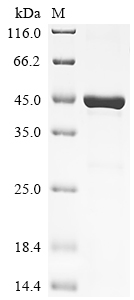In order to produce the recombinant rat phospholipase A2 group XV (Pla2g15) in E. coli, CUSABIO designs a plasmid vector containing the open reading frame (ORF) of the desired Pla2g15 protein (34-413aa). This ORF is fused with a 10xHis-tag at the N-terminus and a Myc-tag at the C-terminus. The resulting recombinant plasmid vector is then introduced into E. coli cells to enable the expression of the desired recombinant Pla2g15 protein. Following successful expression, the E. coli cells are harvested via centrifugation and subsequently lysed to release the cellular contents, which include the recombinant rat Pla2g15 protein. The purification process is carried out to isolate the recombinant Pla2g15 protein from the cell lysate, resulting in a purity level of up to 90% as confirmed by SDS-PAGE analysis.






